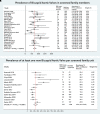Family screening for bicuspid aortic valve and aortic dilatation: a meta-analysis
- PMID: 37288540
- PMCID: PMC10702468
- DOI: 10.1093/eurheartj/ehad320
Family screening for bicuspid aortic valve and aortic dilatation: a meta-analysis
Abstract
Aims: International guidelines recommend screening of first-degree relatives (FDR) of people with bicuspid aortic valves (BAVs). However, the prevalence of BAV and of aortic dilatation amongst family members is uncertain.
Methods and results: A systematic review and meta-analysis of original reports of screening for BAV. Databases including MEDLINE, Embase, and Cochrane CENTRAL were searched from inception to December 2021 using relevant search terms. Data were sought on the screened prevalence of BAV and aortic dilatation. The protocol was specified prior to the searches being performed, and standard meta-analytic techniques were used. Twenty-three observational studies met inclusion criteria (n = 2297 index cases; n = 6054 screened relatives). The prevalence of BAV amongst relatives was 7.3% [95% confidence interval (CI) 6.1%-8.6%] overall and per family was 23.6% (95% CI 18.1%-29.5%). The prevalence of aortic dilatation amongst relatives was 9.4% (95% CI 5.7%-13.9%). Whilst the prevalence of aortic dilatation was particularly high in relatives with BAV (29.2%; 95% CI 15.3%-45.1%), aortic dilatation alongside tricuspid aortic valves was a more frequent finding, as there were many more family members with tricuspid valves than BAV. The prevalence estimate amongst relatives with tricuspid valves (7.0%; 95% CI 3.2%-12.0%) was higher than reported in the general population.
Conclusion: Screening family members of people with BAV can identify a cohort substantially enriched for the presence of bicuspid valve, aortic enlargement, or both. The implications for screening programmes are discussed, including in particular the substantial current uncertainties regarding the clinical implications of aortic findings.
Keywords: Aortic dilatation; Benefits vs. harms; Bicuspid aortic valve; First-degree relatives; Prevalence; Screening; UK National Screening Guidance.
© The Author(s) 2023. Published by Oxford University Press on behalf of the European Society of Cardiology.
Figures




Comment in
-
Family screening for bicuspid aortic valve: indicated, but easy to implement?Eur Heart J. 2023 Sep 1;44(33):3165-3167. doi: 10.1093/eurheartj/ehad057. Eur Heart J. 2023. PMID: 37287349 No abstract available.
References
-
- Michelena HI, Desjardins VA, Avierinos J-F, Russo A, Nkomo VT, Sundt TM, et al. . Natural history of asymptomatic patients with normally functioning or minimally dysfunctional bicuspid aortic valve in the community. Circulation 2008;117:2776–2784. 10.1161/CIRCULATIONAHA.107.740878 - DOI - PMC - PubMed
Publication types
MeSH terms
LinkOut - more resources
Full Text Sources
Medical
Miscellaneous

